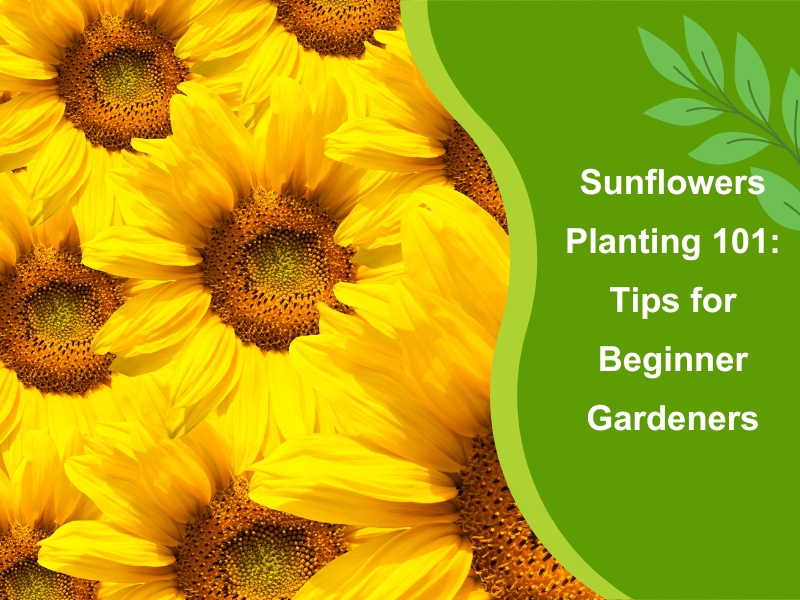Sunflowers are beautiful to the eyes and a pleasure to cultivate. Because of their tall stems and bright flowers, they are an adored pick among gardeners of any expertise level.
Besides their beauty, sunflowers are incredibly easy to grow, making them a perfect choice for new gardeners.
Sunflowers’ cheerful presence can brighten up any space, and growing them from seed is a rewarding experience. This guide will explore the basic concept of planting and maintaining sunflowers, which guarantees flourishing plants.
Which sunflower is perfect for your garden?
Sunflowers come in a dazzling array of sizes, colours, and growth habits, offering various benefits for any garden. From towering giants to petite dwarfs, a sunflower suits every space and style.
Here are some well-known sunflower types to inspire your garden:
- Giant Sunflowers: These majestic blooms can soar to 10 feet, making a bold statement in any landscape. Varieties like Russian Giant and American Giant are popular choices.
- Dwarf Sunflowers: Perfect for containers or small gardens, these compact plants typically reach 2 to 4 feet tall.
- Branching Sunflowers: Enjoy extended bloom time with these prolific varieties that produce multiple flowers on each plant.
- Autumn Beauty Sunflowers: These unique sunflowers, which come in hues beyond the traditional yellow, will add vibrant colour to your garden.
How do you choose the proper sunflowers for your space and preferences?
When choosing a sunflower variety, consider the following factors:
- Garden space: Determine the available area for your sunflowers.
- Climate: Ensure the variety you select is suitable for your local climate.
- Purpose: Decide if you want to grow sunflowers for ornamental display or seed production.
- Aesthetic preference: Choose a sunflower that complements your garden’s style and colour scheme.
Some sunflower breeders focus on developing varieties with exceptional height, while others prioritise larger, more colourful blooms. Ultimately, the best sunflower for you is the one that brings you joy.
What can you do to create the ideal growing conditions for your sunflowers?
Sunflowers thrive in rich, well-drained soil bathed in sunlight. Follow these steps to prepare the ideal garden bed for these magnificent blooms that offer numerous benefits, from attracting pollinators to producing nutritious seeds.
- Choose a sunny spot:
-
- Select a location that receives at least six hours of direct sunlight daily.
-
- Ensure the soil drains well to prevent waterlogging.
-
- Aim for a soil pH between 6.0 and 7.5 for optimal growth.
- Build rich soil:
-
- Loosen the soil to a depth of 12 inches to allow for root penetration.
-
- Incorporate generous amounts of compost or well-rotted manure to improve soil fertility and drainage. These organic materials provide essential nutrients for healthy sunflower growth.
- Understand your soil:
-
- Invest in a soil test kit to determine your pH level accurately.
-
- Adjust the pH as needed by adding lime to increase alkalinity or sulphur to increase acidity.
- Feed your sunflowers:
-
- Sunflowers are heavy feeders, so ensure your soil is nutrient-rich.
-
- Amend the soil with additional compost or a balanced fertiliser with ample nitrogen to support vigorous growth.
Tip: For larger sunflower varieties, consider planting them near a fence or building to protect them from strong winds.
When to plant sunflower seeds
Once your garden bed is prepared, it’s time to sow sunflower seeds.
- Timing: Plant sunflowers after the last frost when soil temperatures reach at least 60°F (15°C). Warm soil is essential for germination.
- Planting depth: Sow seeds about 1 inch deep. For optimal growth, space them 6 inches apart for smaller varieties and 12 inches for more giant sunflowers.
- Watering: Keep the soil consistently moist after planting until seedlings emerge. Once established, sunflowers generally require 1-1.5 inches of water per week.
- Thinning: When seedlings are a few inches tall, thin them out to the most potent plants, spacing them 6-12 inches apart.
How do you care for sunflowers to ensure healthy growth and beautiful blooms?
Sunflowers are relatively low-maintenance, but extra care can significantly improve their growth and appearance.
- Water wisely: While sunflowers are drought-tolerant, making them an excellent choice for water saving gardens, consistent moisture promotes healthier growth. Deep watering once weekly is generally sufficient but increases frequency during hot, dry spells. Avoid overwatering, as this can lead to root rot.
- Feed carefully: Sunflowers are moderate feeders. Use a balanced fertiliser sparingly to encourage growth and larger blooms. Over-fertilization can harm the plants, so always follow the fertiliser package instructions.
- Provide support: Tall sunflower varieties may need staking to prevent them from toppling over in windy conditions. Use garden stakes and plant ties for sturdy support.
- Mulch for benefits: Applying a layer of organic mulch, such as hay or wood chips, around your sunflowers helps retain soil moisture, suppress weeds, and regulate soil temperature.
- Protect from pests and diseases: Sunflowers generally resist pests and diseases. However, watch for common garden pests like aphids and birds. If necessary, implement organic pest control measures.
Tip: Ensure your sunflowers receive at least six hours of direct sunlight daily for optimal growth.
Conclusion
Sunflowers are more than just beautiful faces; they are beacons of life and vitality for your garden. Their cheerful blooms attract beneficial insects, their seeds nourish birds, and their towering presence adds a touch of magic to any space. Easy to cultivate, even in containers, they are a rewarding addition to any green thumb’s repertoire. So, why wait? Let the sunshine in your garden be with these golden giants!
Transform your garden with A1 Gardening & Landscaping Sydney!
Sunflowers are more than just beautiful; they are ecological powerhouses that bring joy to humans and wildlife. They offer many benefits, from attracting beneficial insects and improving soil health to providing nutritious seeds for birds and people. Even novice gardeners can cultivate these radiant blooms with some care and experience the satisfaction of watching them thrive. So, let the sunshine in your garden and embark on your sunflower-growing adventure today!
Ready to elevate your outdoor space beyond sunflowers? A1 Gardening & Landscaping Sydney offers comprehensive landscaping services to transform your garden into a stunning oasis. From design and installation to maintenance and care, our team of experts is dedicated to bringing your vision to life.
Contact A1 Gardening & Landscaping Sydney Sydney today for a free consultation, and let’s create a garden you’ll love.

